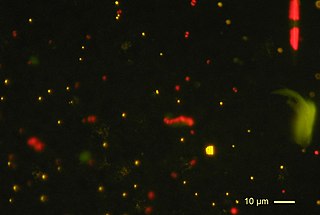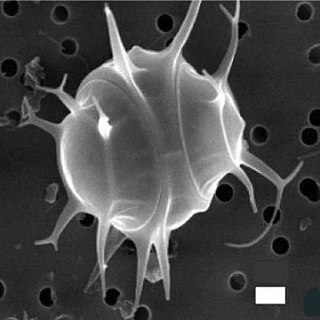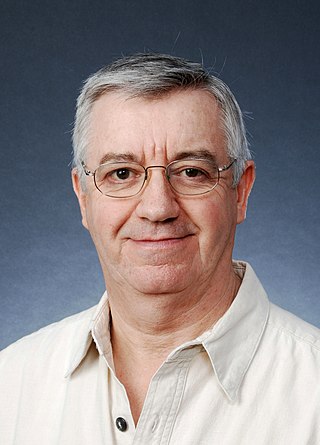
Prochlorococcus is a genus of very small (0.6 μm) marine cyanobacteria with an unusual pigmentation. These bacteria belong to the photosynthetic picoplankton and are probably the most abundant photosynthetic organism on Earth. Prochlorococcus microbes are among the major primary producers in the ocean, responsible for a large percentage of the photosynthetic production of oxygen. Prochlorococcus strains, called ecotypes, have physiological differences enabling them to exploit different ecological niches. Analysis of the genome sequences of Prochlorococcus strains show that 1,273 genes are common to all strains, and the average genome size is about 2,000 genes. In contrast, eukaryotic algae have over 10,000 genes.
Prochlorophyta is a group of photosynthetic bacteria, an important component of picoplankton. These oligotrophic organisms are abundant in nutrient poor tropical waters and use a unique photosynthetic pigment, divinyl-chlorophyll, to absorb light and acquire energy. Prochlorophyta lack red and blue phycobilin pigments and have stacked thylakoids, making them distinctly different from Cyanobacteria, but some authors consider them as part of the Cyanobacteria, as the group Prochlorales.
High-nutrient, low-chlorophyll (HNLC) regions are regions of the ocean where the abundance of phytoplankton is low and fairly constant despite the availability of macronutrients. Phytoplankton rely on a suite of nutrients for cellular function. Macronutrients are generally available in higher quantities in surface ocean waters, and are the typical components of common garden fertilizers. Micronutrients are generally available in lower quantities and include trace metals. Macronutrients are typically available in millimolar concentrations, while micronutrients are generally available in micro- to nanomolar concentrations. In general, nitrogen tends to be a limiting ocean nutrient, but in HNLC regions it is never significantly depleted. Instead, these regions tend to be limited by low concentrations of metabolizable iron. Iron is a critical phytoplankton micronutrient necessary for enzyme catalysis and electron transport.

Ramon Margalef i López was a Spanish biologist and ecologist. He was Emeritus Professor of Ecology at the Faculty of Biology of the University of Barcelona. Margalef, one of the most prominent scientists that Spain has produced, worked at the Institute of Applied Biology (1946–1951), and at the Fisheries Research Institute, which he directed during 1966–1967. He created the Department of Ecology of the University of Barcelona, from where he trained a huge number of ecologists, limnologists and oceanographers. In 1967 he became Spain's first professor of ecology.

Ocean fertilization or ocean nourishment is a type of technology for carbon dioxide removal from the ocean based on the purposeful introduction of plant nutrients to the upper ocean to increase marine food production and to remove carbon dioxide from the atmosphere. Ocean nutrient fertilization, for example iron fertilization, could stimulate photosynthesis in phytoplankton. The phytoplankton would convert the ocean's dissolved carbon dioxide into carbohydrate, some of which would sink into the deeper ocean before oxidizing. More than a dozen open-sea experiments confirmed that adding iron to the ocean increases photosynthesis in phytoplankton by up to 30 times.

Photosynthetic picoplankton or picophytoplankton is the fraction of the phytoplankton performing photosynthesis composed of cells between 0.2 and 2 µm in size (picoplankton). It is especially important in the central oligotrophic regions of the world oceans that have very low concentration of nutrients.

Synechococcus is a unicellular cyanobacterium that is very widespread in the marine environment. Its size varies from 0.8 to 1.5 µm. The photosynthetic coccoid cells are preferentially found in well–lit surface waters where it can be very abundant. Many freshwater species of Synechococcus have also been described.

Cyanophages are viruses that infect cyanobacteria, also known as Cyanophyta or blue-green algae. Cyanobacteria are a phylum of bacteria that obtain their energy through the process of photosynthesis. Although cyanobacteria metabolize photoautotrophically like eukaryotic plants, they have prokaryotic cell structure. Cyanophages can be found in both freshwater and marine environments. Marine and freshwater cyanophages have icosahedral heads, which contain double-stranded DNA, attached to a tail by connector proteins. The size of the head and tail vary among species of cyanophages. Cyanophages infect a wide range of cyanobacteria and are key regulators of the cyanobacterial populations in aquatic environments, and may aid in the prevention of cyanobacterial blooms in freshwater and marine ecosystems. These blooms can pose a danger to humans and other animals, particularly in eutrophic freshwater lakes. Infection by these viruses is highly prevalent in cells belonging to Synechococcus spp. in marine environments, where up to 5% of cells belonging to marine cyanobacterial cells have been reported to contain mature phage particles.

The microbial loop describes a trophic pathway where, in aquatic systems, dissolved organic carbon (DOC) is returned to higher trophic levels via its incorporation into bacterial biomass, and then coupled with the classic food chain formed by phytoplankton-zooplankton-nekton. In soil systems, the microbial loop refers to soil carbon. The term microbial loop was coined by Farooq Azam, Tom Fenchel et al. in 1983 to include the role played by bacteria in the carbon and nutrient cycles of the marine environment.
The Ramon Margalef Prize in Ecology is a prize awarded annually by the Generalitat de Catalunya to recognize an exceptional scientific career or discovery in the field of ecology or other environmental sciences. The award was created to honor the life and work of Ramon Margalef. The award has been presented every year since 2004 and comes with an honorarium of €80,000 and a sculpture representing a microalga, called Picarola margalefii. It is open to ecologists from anywhere in the world.

Bacterioplankton refers to the bacterial component of the plankton that drifts in the water column. The name comes from the Ancient Greek word πλανκτος, meaning "wanderer" or "drifter", and bacterium, a Latin term coined in the 19th century by Christian Gottfried Ehrenberg. They are found in both seawater and freshwater.
Auxiliary metabolic genes (AMGs) are found in many bacteriophages but originated in bacterial cells. AMGs modulate host cell metabolism during infection so that the phage can replicate more efficiently. For instance, bacteriophages that infect the abundant marine cyanobacteria Synechococcus and Prochlorococcus (cyanophages) carry AMGs that have been acquired from their immediate host as well as more distantly-related bacteria. Cyanophage AMGs support a variety of functions including photosynthesis, carbon metabolism, nucleic acid synthesis and metabolism. AMGs also have broader ecological impacts beyond their host including their influence on biogeochemical cycling.
Bacterioplankton counting is the estimation of the abundance of bacterioplankton in a specific body of water, which is useful information to marine microbiologists. Various counting methodologies have been developed over the years to determine the number present in the water being observed. Methods used for counting bacterioplankton include epifluorescence microscopy, flow cytometry, measures of productivity through frequency of dividing cells (FDC), thymidine incorporation, and leucine incorporation.

The Parmales are an order of marine microalgae within the Bolidophyceae class. They are found worldwide and characterized by a cell wall composed of 5-8 interlocking silica plates with distinct forms. They were initially thought to be loricate choanoflagellates but were shown to be a separate phyla entirely upon the discovery of chloroplasts, placing it among the photosynthetic stramenopiles.
William Li is a Canadian biological oceanographer who did research on marine picoplankton, marine macroecology, ocean surveys of plankton from measurements of flow cytometry, and detection of multi-annual ecological change in marine phytoplankton.

Trevor Charles Platt was a British and Canadian biological oceanographer who was distinguished for his fundamental contributions to quantifying primary production by phytoplankton at various scales of space and time in the ocean.
Transparent exopolymer particles (TEPs) are extracellular acidic polysaccharides produced by phytoplankton and bacteria in saltwater, freshwater, and wastewater. They are incredibly abundant and play a significant role in biogeochemical cycling of carbon and other elements in water. Through this, they also play a role in the structure of food webs and trophic levels. TEP production and overall concentration has been observed to be higher in the Pacific Ocean compared to the Atlantic, and is more related to solar radiation in the Pacific. TEP concentration has been found to decrease with depth, having the highest concentration at the surface, especially associated with the SML, either by upward flux or sea surface production. Chlorophyll a has been found to be the best indicator of TEP concentration, rather than heterotrophic grazing abundance, further emphasizing the role of phytoplankton in TEP production. TEP concentration is especially enhanced by haptophyte phytoplanktonic dominance, solar radiation exposure, and close proximity to sea ice. TEPs also do not seem to show any diel cycles. High concentrations of TEPs in the surface ocean slow the sinking of solid particle aggregations, prolonging pelagic residence time. TEPs may provide an upward flux of materials such as bacteria, phytoplankton, carbon, and trace nutrients. High TEP concentrations were found under arctic sea ice, probably released by sympagic algae. TEP is efficiently recycled in the ocean, as heterotrophic grazers such as zooplankton and protists consume TEP and produce new TEP precursors to be reused, further emphasizing the importance of TEPs in marine carbon cycling. TEP abundance tends to be higher in coastal, shallow waters compared to deeper, oceanic waters. Diatom-dominated phytoplankton colonies produce larger, and stickier, TEPs, which may indicate that TEP size distribution and composition may be a useful tool in determining aggregate planktonic community structure.

Marta Estrada Miyares is a Catalan researcher, with a career in oceanography and marine biology. Her most prominent studies are based on the physiological characterization and ecological impact of algae and phytoplankton.
Gabrielle Rocap is an American marine biologist and academic noted for her research on the evolution and ecology of marine bacteria and phytoplankton. She is one of the researchers who discovered microorganisms in the Pacific Ocean that consume arsenic to survive. She is currently a professor in the Oceanography department of the University of Washington.
Debbie Lindell is the Dresner Chair in life sciences and medicine at Technion - Israel Institute of Technology. She is known for her work on the interactions between viruses and their hosts in marine environments.











